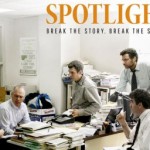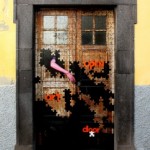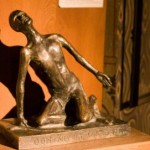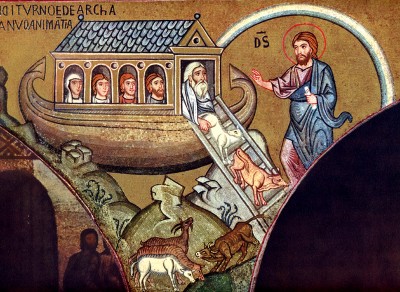 The Turning Season. Lent. Solemnity falls upon the worship of the church, the extravagant lights of Epiphany are doused and the Alleluias are packed away.
The Turning Season. Lent. Solemnity falls upon the worship of the church, the extravagant lights of Epiphany are doused and the Alleluias are packed away.
Yet the season begins with a twinkle, a gleam of hospitable pleasure in the readings this week, a titter if not a guffaw, and in it a rueful recognition of human stubbornness.
These are stories of New Beginnings: Noah, newly off the Ark; and Jesus, full of the Holy Spirit, declaring Good News after John has been arrested. Something benevolent is afoot, at least at the start of the stories. And that’s merry, not sorrowful news.
From N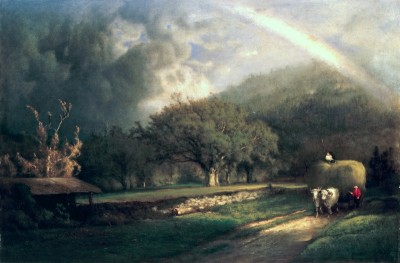 oah’s story: the long declaration of the rainbow covenant, the promise that never again will the fury of God be loosed upon the world. The Old Testament preamble to this originally Egyptian tale recounts the mingling of humans with ‘the sons of the gods’, who were perhaps an ancient race of giants, perhaps just pagan folk, later on some said they were fallen angels, ‘heroes of old’, whose influence on people caused God to regret that the spirit of holiness rested in these mere mortals. And God determined to destroy them with the flood. But not Noah, whom God loved. Noah, with God as chief advisor, set about saving the world — with the help of the trees, the ocean, the creatures, the birds, all of whom made their journey possible. And in the journey, Noah saved the seeds of everything. By the time he left the Ark he’d earned the Rainbow, God’s promise to all people forever.
oah’s story: the long declaration of the rainbow covenant, the promise that never again will the fury of God be loosed upon the world. The Old Testament preamble to this originally Egyptian tale recounts the mingling of humans with ‘the sons of the gods’, who were perhaps an ancient race of giants, perhaps just pagan folk, later on some said they were fallen angels, ‘heroes of old’, whose influence on people caused God to regret that the spirit of holiness rested in these mere mortals. And God determined to destroy them with the flood. But not Noah, whom God loved. Noah, with God as chief advisor, set about saving the world — with the help of the trees, the ocean, the creatures, the birds, all of whom made their journey possible. And in the journey, Noah saved the seeds of everything. By the time he left the Ark he’d earned the Rainbow, God’s promise to all people forever.
This is not a story about purification. In the Ark (an Egyptian word, tebah, meaning box, or coffin, or life preserver) Noah places all the unclean animals of the world, in close proximity, in prolonged intimacy, in utter dependency on one another. This is not a story about keeping clean. This is not an exercise in eugenics. This is not a biblical genocide. This is a salvation story, a tale of commitment to the opposite of genocide, commitment to preserving the diversity of life and all of life’s messiness. And God is actively part of this commitment.
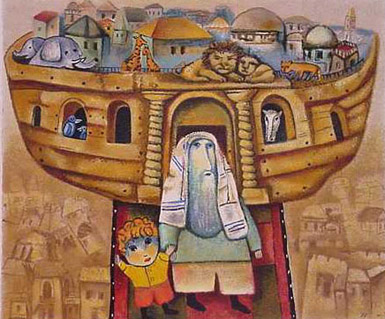 The good news in this story is salvation. So the preamble, which is not part of the story in other, earlier, cultures, may be wrong. The Rainbow Finale is the proof of God’s steadfast intentions, the proof Mary Oliver writes about:
The good news in this story is salvation. So the preamble, which is not part of the story in other, earlier, cultures, may be wrong. The Rainbow Finale is the proof of God’s steadfast intentions, the proof Mary Oliver writes about:
Shadows
Everyone knows the great energies running amok cast
terrible shadows, that each of the so-called
senseless acts has its thread looping
back through the world and into a human heart.
. . . . . I don’t mean
there are no bodies in the river,
or bones broken by the wind. I mean
everyone who has heard the lethal train-roar
of the tornado swears there was no mention ever
of any person, or reason – I mean
the waters rise without any plot upon
history, or even geography. Whatever
power of the earth rampages, we turn to it
dazed but anonymous eyes; whatever
the name of the catastrophe, it is never
the opposite of love.
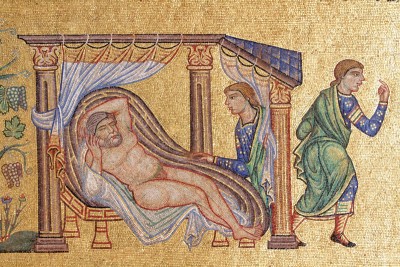 And the case-closing proof is in the coda, the two verses that follow: Noah gets really, really drunk. He passes out naked in his tent. His youngest son walks in, and sees Noah’s penis, his ‘nakedness’, Scripture calls it, and he tells his two brothers, who cover their father without looking. An oddly nonsexual, slightly homo-erotic, and very suggestive text, this fragment is haunted by desire, and by unexpressed acts that may well have happened on board the Ark. Why are we humans so haunted by our sexuality, so afraid of our nakedness, as if, with clothes on, we come from God’s shaping hand, not from human passionate embrace, but naked, more than our genitals is exposed.
And the case-closing proof is in the coda, the two verses that follow: Noah gets really, really drunk. He passes out naked in his tent. His youngest son walks in, and sees Noah’s penis, his ‘nakedness’, Scripture calls it, and he tells his two brothers, who cover their father without looking. An oddly nonsexual, slightly homo-erotic, and very suggestive text, this fragment is haunted by desire, and by unexpressed acts that may well have happened on board the Ark. Why are we humans so haunted by our sexuality, so afraid of our nakedness, as if, with clothes on, we come from God’s shaping hand, not from human passionate embrace, but naked, more than our genitals is exposed.
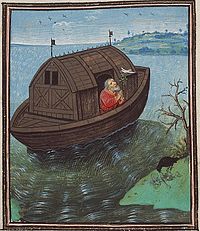 When he wakes, a badly hung over Noah curses his youngest son, repeating, at the start of the ‘new’world, all that had gone wrong before the Flood; drunkenness, quarreling, division and harsh judgment, the Sins of Humankind, written down for us to see on the Shores of New Beginnings. God’s promise of worldwide inclusion meets Noah’s excess, bad judgment, and excluding curse.
When he wakes, a badly hung over Noah curses his youngest son, repeating, at the start of the ‘new’world, all that had gone wrong before the Flood; drunkenness, quarreling, division and harsh judgment, the Sins of Humankind, written down for us to see on the Shores of New Beginnings. God’s promise of worldwide inclusion meets Noah’s excess, bad judgment, and excluding curse.
And so it goes for Saviors. The rise and fall of human meanness of spirit means their work is never finished. The new era begins, full of promise and full of work to be done, needing relief from all that humiliates, annoys, debases, truncates life, needing restoration even in the midst of salvation.
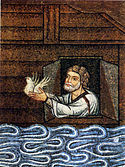 Jesus, filled with the Holy Spirit, walks onto the beach of New Beginnings just as the storm surge has claimed John’s life. He calls upon everyone to repent – and believe the Good News. Why is it always so much easier to believe Bad News? And why do we slide away from his petition, that we stop seeing and proclaiming the darkness, and begin to proclaim the good news?
Jesus, filled with the Holy Spirit, walks onto the beach of New Beginnings just as the storm surge has claimed John’s life. He calls upon everyone to repent – and believe the Good News. Why is it always so much easier to believe Bad News? And why do we slide away from his petition, that we stop seeing and proclaiming the darkness, and begin to proclaim the good news?
We cannot earn our way into the kingdom by self-imporvement – by abstaining from the pleasures of this world – by not eating meat or sweets, by shunning sex, or by judging others . Jesus wades into all these forbidden things, wades into worlds of forbidden people. He makes of his life an Ark of survival. John, who called everyone into Brother and Sisterhood, is gone. Many, who tried to believe, are in despair.
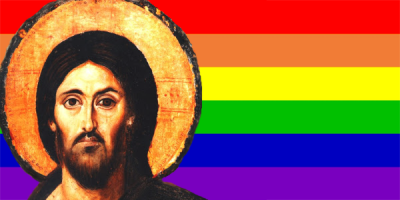 Damn the arrogant, powerful, thugs, who shock us with their flagrant evil, their ugly words, their dominant wickedness. Jesus calls us away from their news, and into good news, that the world is beloved, and so are all of us, unclean as we are, drunk as we are at the moment, fallen as we are on the shores of new beginnings. Believe in the good news, he calls.
Damn the arrogant, powerful, thugs, who shock us with their flagrant evil, their ugly words, their dominant wickedness. Jesus calls us away from their news, and into good news, that the world is beloved, and so are all of us, unclean as we are, drunk as we are at the moment, fallen as we are on the shores of new beginnings. Believe in the good news, he calls.
And God looked at the world God had made. And behold it was very good. Jesus, the Rainbow Man, shines, as Lent begins.
________________________________________________________
Illustrations:
1. God Orders Noah to leave the Ark. Cappella Palatina di Palermo, mid 12th c. Italy. Vanderbilt Divinity School Library, Art in the Christian Tradition.
2. Rainbow In the Berkshire Hills. George Inness, 1869, White House Administrative Office, DC. Vanderbilt Divinity School Library, Art in the Christian Tradition.
3. Noah’s Ark. Noah sends off a dove, Jean Dreux, c.-1450-1460 Museum Meermaano Westreenianum, The Hague. Wikipedia Image.
4. Noah’s nakedness. Basilica di San Marco, Venice. Vanderbilt Divinity School Library, Art in the Christian Tradition.
5. Noah. 12th c. St. Marks Basilica Venice. Wikipedia.
6. Rainbow Jesus. Poster. Google Images.


